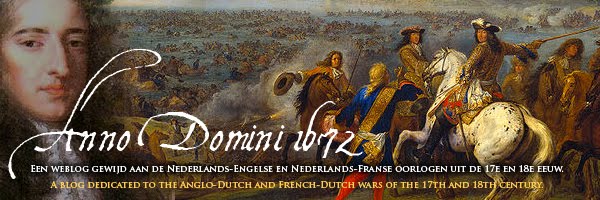
Op 31 maart 1672 wilde Kapitein Jacob Visscher, kapitein der mariniers, zich inschepen op de Enkhuizer Maagd, maar hij werd naar het front gezonden en sneuvelde later bij Woerden.
VISSCHER (Jacob Gerritz.), geb. te Enkhuizen 1643, ongeh. overleden te Woerden 12 Oct. 1672, zoon van den voorgaanden en Aefje Claesdr.
Uit een Enkhuizensch regeeringsgeslacht gesproten, verkoos hij den krijgmansstand en diende de Republiek zoowel te water als te land tegen Engeland, Frankrijk en Munster. In 1668 was hij luitenant van eene compagnie voetknechten en bevalen de Burgemeesters van Enkhuizen den 4den Juli van dat jaar hem aan voor bevordering tot capitein als van ‘manlyke couragie en goet beleyt, soo int afweeren van de Engelse branders op de rivier van Londen als tegen de Monsterse voor desen.’ Kort daarna werd hij capitein in de plaats van Willem Croesen, overleden in Juli 1668, wiens weduwe in 1691 nog niet voldaan schijnt te zijn geweest van de door Visscher overgenomen wapens der compagnie ad ƒ 630.
Blijkens Missiveboek van Burg. van Enkh., dd. 31 Maart 1672 bood hij aan zich met zijne compagnie in te schepen op de Enkhuizer Maagd onder bevel van den Schout bij Nacht David Vlug, doch dit ging niet door en hij werd naar het front gezonden. Hij sneuvelde 12 October 1672 bij den Zaagmolen omtrent Woerden, door een musquetkogel in het hoofd getroffen. Naar zijn lijk werd later te vergeefs gezocht, hetgeen begrijpelijk is daar de molen waarbij het lijk was achtergelaten, door den vijand werd verbrand.
Centen, Hist. v. Enkh., vervolg 353, geeft eene necrologie waarin persoonsbeschrijving ‘welgemaakt en fris van persoon’ en een overlijdensgedicht waarin woordspelingen en vermelding van dappere daden, en verder bestaat in druk een gedicht van H. van der Meer uitgegeven bij Egbert van den Hoof in de Bonte Drukker te Enkh.: Uitvaart der Edele en Manhafte Helden, de Heer IJsbrand Boterkoper bevelhebber van Crêvecoeur en de Heer Jacob Visscher, beide hopmannen van een Bende Zee-soldaten, doorschoten van de Fransche ondrent Woerden den 12 van Wynmaant 1672.
Zijn beeltenis geschilderd door D. van Hagen bevindt zich in familie-archief Semeyns.
On march
Bron: http://www.inghist.nl/retroboeken/nnbw/#4:701
~~
On the 31st of March 1672, therefore 338 years ago, Captain of the Marines, Jacob Visscher, tried to board the ship 'Enkhuizer Maegd', but was sent to front instead, where he died at Woerden October 1672.
His picture is now in the city hall of Enkhuizen. I took the text from this website which lists biographies of famous Dutchmen.










































